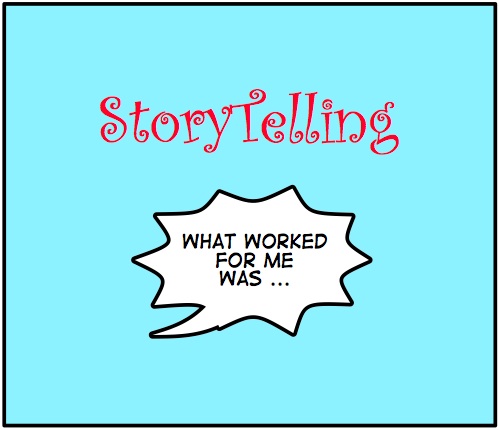Storytelling reveals meaning without committing the error of defining it. — Hannah Arendt
 In another post on creating a memorable learning experience, I promised to talk more about storytelling. The story and the telling are distinct parts of storytelling. To hold your audience’s attention, consider both. Today I’ll focus on why including stories in presentations is valuable and the types of stories that can be used. One presentation may use multiple types of stories. Next Thursday, I’ll give effective ways to tell a story.
In another post on creating a memorable learning experience, I promised to talk more about storytelling. The story and the telling are distinct parts of storytelling. To hold your audience’s attention, consider both. Today I’ll focus on why including stories in presentations is valuable and the types of stories that can be used. One presentation may use multiple types of stories. Next Thursday, I’ll give effective ways to tell a story.
9 Reasons to Use Stories in Presentations
1. Stories can create an experience that listeners can step into and identify with. For a conference of cooks:
List the dos and don’ts in an industrial kitchen.
OR
Also, tell the story, I Cooked My Way Out of a Sunk Soufflé, showing the dos and don’ts.
2. Stories can cause listeners to learn without realizing it. For children:
Warn them not to do poor work to hurry and play.
OR
Tell them the story: The Three Little Pigs.
3. Stories can show listeners solutions to moral predicaments. During a school assembly:
List school rules about bullying.
OR
Also, tell the story, My Friend Jack Turned a Bully into a Friend.
4. Stories can touch listeners and call them to action. During a dentist visit:
As usual, the dentist told me to start flossing my teeth. (I didn’t.)
OR
Finally, he told me about a patient who didn’t heed his directive, then showed me a picture of a person’s black gums. I have flossed once a day ever since!
5. Stories can get listeners talking. In a leadership workshop, ask:
“What are elements of making a wining decision?”
OR
Tell the story of the three whales trapped under the ice. Then ask, “What would you consider when faced with the choices: save the endangered whales at $1 million or let local whalers feed the natives?”
6. Stories are more interesting to listeners than shoveled information. For a class on storytelling:
List 9 reasons to use stories in presentations.
OR
Also sprinkle mini-stories and examples among the reasons to stimulate listeners’ thoughts. :O)
7. Stories can show listeners how to use information. In a Bible Study Fellowship training session for Children’s Leaders:
Read the tips for large-muscle exercises from the manual.
OR
As our supervisor did, ask the seasoned leaders to tell the actual experience of their most popular large-muscle idea.
8. Stories can encourage listeners to see what’s possible. In a workshop on self-publishing:
Tell the steps to self-publish.
OR
Also relate the story of how you did it.
9. Stories are memorable and make a message easy for listeners to pass on to others. In a crime awareness class:
Tell dos and don’ts.
OR
As our presenting police officer did, tell us stories of what happened when people failed to heed such advice. I shared his stories with other women.
5 Types of Stories
1. To Entertain – regale listeners, not send a message. Often jokes are designed solely to tickle funny bones. Campfire ghost stories are usually intended to keep listeners awake listening for tread-on sticks.
2. To Teach – tell parables as Jesus did using common life events of His day to teach about the kingdom of God.
3. To Persuade – relate true testimonies to draw listeners to action or make life changes.
4. To Apply – give examples how an idea or an item can be used.
5. To Inform – impart facts in travel logs, documentaries, and biographies.
What story worked well in a presentation you attended or where you were the speaker?
To CONTACT ME use the form. To LEAVE A COMMENT use the COMMENT option below the form.
[contact-form][contact-field label=’Name’ type=’name’ required=’1’/][contact-field label=’Email’ type=’email’ required=’1’/][contact-field label=’Comment’ type=’textarea’ required=’1’/][/contact-form]






 RSS - Posts
RSS - Posts
I collect stories to read to support what I’m presenting. I have used Zoe’s “Walking with Daddy” from Pearls in the Muddle as an example of letting God into all our decisions. Today is Thanksgiving. I might read Max Lucado’s “Gratitude for Ungrateful Days” from Every Day Deserves a Chance. Google the title and you can read “Gratitude for Ungrateful Days” and go from griping to gratitude.
Marcia, always good to have story examples on hand. I’m sure you’re ready for those moments when you’re asked to fill in for someone else. I’ll look up the Gratitude reading.